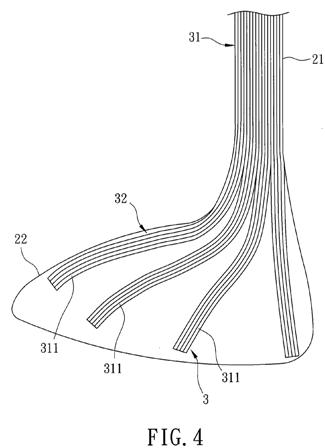How Much is Your Hosel, Ferrule, and Epoxy Hurting You?
As an avid golfer and equipment junkie, I go through a lot of golf clubs. Not once have I thought about the negative performance impact associated with a club’s hosel, ferrule, or epoxy; probably because that is “just how it is done.” Perhaps such old-school thinking is outdated and due for a change, particularly if you are looking for the ultimate custom club. After all, club makers are always searching for every last bit of discretionary weight to give them a leg up on the competition. Since I recently read about Rickie’s $720 shaft, one has to wonder what this club would cost.
I am referring to a club that is disclosed in a patent application that recently published as US Pub. No. 20120115631 titled “Golf Club.” The application describes the invention as:



The application goes on to explain:
Dave Dawsey - The Golf Invention Attorney
I am referring to a club that is disclosed in a patent application that recently published as US Pub. No. 20120115631 titled “Golf Club.” The application describes the invention as:
A golf club includes a golf club head, and a shaft extending from one side of the golf club head. The shaft and the golf club head are made as a one-piece body from a prepreg sheet including a fiber structure impregnated with a resin. The fiber structure extends continuously from the shaft to the golf club head.



The application goes on to explain:
[0004] 2. Description of the Related ArtInteresting idea, but is it practical?
[0005] Referring to Figs. 1 and 2, a conventional golf club 1 includes a golf club head 11, a shaft 12 inserted into the golf club head 11, a ferrule 13 sleeved on the top of a hosel 16 that defines the portion of the golf club head 11 to which the shaft 12 is attached, and a grip 14 sleeved on an end of the shaft 12 opposite to the golf club head 11. In the hosel 16, the golf club head 11 is coupled to the shaft 12 using an adhesive 15. When using the golf club 1, the user's power is transmitted to a golf ball (not shown) via the grip 14, the shaft 12, and the golf club head 11. However, the conventional golf club 1 still has the following defects:
[0006] 1. The striking performance cannot be fully utilized. This is because the user's power, aside from hitting the golf ball, will also be partially diminished by the adhesive 15 and gaps formed among the constructive elements of the golf club 1.
[0007] 2. The error tolerance for striking is poor. The inclusion of the ferrule 13, the adhesive 15, and other joining structures (not shown) among the elements of the golf club 1 moves a center of gravity of the golf club 1 upward and increases the weight of the golf club 1. This may reduce the error tolerance of striking, and is adverse to the adjustment of the center of gravity and weight of the golf club 1.
SUMMARY OF THE INVENTION
[0008] Therefore, an object of the present invention is to provide a golf club that can overcome the aforesaid drawbacks associated with the prior art.
[0009] Accordingly, a golf club of this invention comprises a golf club head, and a shaft extending from one side of the golf club head. The shaft and the golf club head are made as a one-piece body from a prepreg sheet including a fiber structure impregnated with a resin, the fiber structure extending continuously from the shaft to the golf club head.
.
.
.
[0027] Accordingly, the golf club 2 of this invention has the following advantages:
1. Good Striking Efficiency
[0028] Since the fiber structure extends continuously from the shaft 21 to the golf club head 22, and since the shaft 21 and the golf club head 22 are formed as the one-piece body, gaps among constructive elements of the golf club 2, which may diminish the user power, can be effectively avoided and the adhesive is not necessary. Thus, the user's power is almost completely transmitted to the golf club head 22 to result in an improved striking efficiency.
2. Good Error Tolerance for Striking
[0029] As described above, since the shaft 21 and the golf club head 22 are formed as the one-piece body, joining structures for assembling the constructive elements or the adhesive for bonding together the shaft 21 and the golf club head 22 are not necessary. Thus, the total weight of the golf club 2 can be reduced, and the center of gravity of the golf club 2 is relatively low. This is beneficial for the adjustment of the center of gravity and weight of the golf club 2 to increase the error tolerance for striking.
Dave Dawsey - The Golf Invention Attorney

Comments